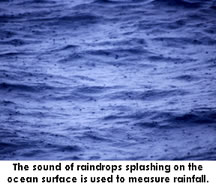One of the biggest effects of climate change on human societies may be a change in global rainfall patterns.

Although we have ready access to local, regional, and national weather information via many sources—TV, radio, newspapers, and the Internet—scientists do not yet know enough about the distribution of rainfall across the globe. Rainfall patterns change over very small space and time scales, making measurements from any single place and time difficult to extrapolate to global scales.
This challenge is even greater over the oceans, where standard rain gauges are impractical. Satellite instruments cannot yet provide global coverage of rainfall patterns. A new method for measuring rainfall at sea is simply to listen to the sound of rain splashing on the ocean surface. This sound is surprisingly loud and has unique characteristics that allow scientists to distinguish it from other sounds and to measure it. Listening devices—or else known as underwater hydrophones—can be deployed at different depths to provide more information.
Researchers are also interested in the distribution of raindrop size. Different types of rainfall—such as the widespread drizzle associated with stratiform clouds, heavy rainfall associated with convective clouds, and rainfall associated with weather fronts—have different drop size distributions. As a result, researchers can classify rainfall by its drop size distribution. |
Different sized raindrops produce different sounds underwater because the raindrop splash depends on the size of the raindrop. As a result, sound can be used to measure the distribution of raindrop sizes in a rainfall and therefore to classify rainfalls.
Researchers at HCMR are trying to link the new underwater sound measurements with other systems—land-based weather radar and rain gauges. Experiments have been conducted in the Ionian Sea, southwest of Greece. There the sea close to shore is very deep, allowing researchers to measure deep ocean sounds in an area covered by land-based radar.
The radar can also measure components of the drop size distribution and the spatial distribution of the rain. From underwater acoustic instruments, we can measure the shape of individual raindrops optically.
Together, these measurements shed light on important global rainfall patterns and help validate rainfall measurements by global coverage satellite sensors. Utilizing the underwater acoustic signal from rain will allow rainfall climatology to be measured in many remote or severe weather regions (Atlantic and Pacific ITCZ, North Atlantic, etc.). Finally, the impact of human-generated sound on the marine environment is of growing concern. A collateral result of this work will be to improve the monitoring of marine sound budget providing fundamental baseline data that would allow informed decisions regarding management of sound-producing human activities in the ocean.
|



